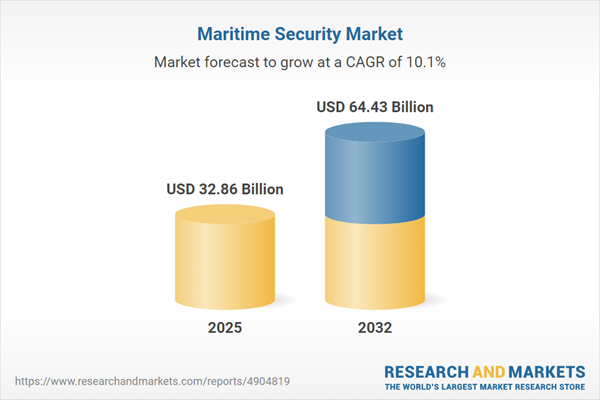Speak directly to the analyst to clarify any post sales queries you may have.
The maritime security market is undergoing major transformation as leaders prioritize digital innovation, integrated risk management, and adherence to strict regulatory standards. Senior decision-makers must adapt security strategies to safeguard increasingly complex global maritime operations.
Market Snapshot: Maritime Security Market Size and Growth
Recent analysis indicates robust expansion in the maritime security market, driven by increased spending on advanced protection solutions and platform integration. Collaborations between port authorities, shipping operators, and asset management teams foster innovation and reinforce security throughout global supply chains. Regulatory evolution and digital tool uptake are influencing industry compliance approaches and accelerating the development of layered security architectures. Organizations are deploying agile, scalable protocols to respond quickly to new maritime security risks, sustaining efficiency across interconnected operations.
Scope & Segmentation of the Maritime Security Market
This report targets the information needs of executive leaders, offering detailed segmentation and relevant insights on essential aspects influencing the maritime security sector:
- Component: Professional services support risk management frameworks through consulting, deployment, integration, maintenance, and workforce training. Hardware ranges from communication systems to sensor networks and radar technologies, while software platforms facilitate analytics-driven operations and centralized oversight.
- Security Type: Portfolio includes physical access controls, advanced screening, network defenses, surveillance tools, and integrated analytics, each contributing to high-assurance security solutions for port and offshore assets.
- Platform: Solutions are tailored for coastal facilities, shipyards, bulk carriers, offshore and inland installations, and support vessels. Cohesive protection is established across maritime and land domains, enabling consistent security objectives.
- Deployment: Systems are implemented both at sea and onshore, utilizing real-time monitoring, scenario-based threat responses, and managerial decision-support from centralized command centers.
- End User: Commercial shipping lines, cruise operators, naval forces, offshore energy entities, and port authorities benefit from customized solutions aligned to their specific requirements and regulatory obligations.
- Geographic Coverage: The market is examined regionally across the Americas, Europe, Middle East and Africa, and Asia-Pacific, demonstrating how regional compliance trends and technology uptake drive local market progression and operational practices.
- Companies Profiled: Industry leaders such as Lockheed Martin Corporation, Raytheon Technologies Corporation, BAE Systems plc, Thales Group, Northrop Grumman Corporation, SAAB AB, L3Harris Technologies, General Dynamics Corporation, Elbit Systems Ltd., and Indra Sistemas, S.A. play pivotal roles in shaping technology adoption and stabilizing market dynamics.
Key Takeaways: Strategic Insights for Senior Maritime Security Leaders
- Integrated digital and physical security architectures provide unified asset visibility and strengthen risk management, supporting both domestic and international operations.
- Deployment of AI tools, process automation, and enhanced connectivity streamlines threat detection, allowing rapid, informed interventions in maritime environments.
- Stronger cross-sector collaboration among government, port authorities, and private firms leads to improved information exchange and heightened resilience against service disruptions.
- Updating security infrastructure and prioritizing proactive vulnerability management keeps organizations aligned with shifting threat profiles and compliance standards.
- Emphasis on data analytics and focused workforce training raises readiness and helps organizations adjust policies to meet regulatory and operational changes in the sector.
Tariff Impact on Maritime Security
Recent changes to the United States tariff framework have immediate consequences for procurement planning and supply chain design within the maritime component sector. In response, companies diversify supplier bases, invest in regionalized supply, and establish resilient partnerships to minimize disruptions. The integration of automation in cargo operations further increases supply chain security, providing adaptability as international trade landscapes shift.
Methodology & Data Sources
Insights in this report are derived from primary and secondary research, regulatory reviews, open data, and executive interviews. Maritime security analysts, port leaders, and cybersecurity professionals independently validate data, ensuring content is both accurate and actionable.
Why This Report Matters
- Equips executive leaders with the analytical tools and strategic context needed to design robust maritime security programs and enhance business continuity.
- Supports organizational ability to anticipate regulatory and operational shifts while guiding effective resource deployment and flexible planning.
- Delivers timely, data-backed intelligence on maritime technology adoption and compliance matrices, promoting confident and well-informed decisions at the leadership level.
Conclusion
Addressing rising operational complexity and evolving compliance demands calls for unified maritime security strategies. This report gives senior leaders the critical knowledge required to strengthen security and proactively manage risk in a changing marketplace.
Additional Product Information:
- Purchase of this report includes 1 year online access with quarterly updates.
- This report can be updated on request. Please contact our Customer Experience team using the Ask a Question widget on our website.
Table of Contents
3. Executive Summary
4. Market Overview
7. Cumulative Impact of Artificial Intelligence 2025
Companies Mentioned
The companies profiled in this Maritime Security market report include:- Lockheed Martin Corporation
- Raytheon Technologies Corporation
- BAE Systems plc
- Thales Group
- Northrop Grumman Corporation
- SAAB AB
- L3Harris Technologies, Inc.
- General Dynamics Corporation
- Elbit Systems Ltd.
- Indra Sistemas, S.A.
Table Information
| Report Attribute | Details |
|---|---|
| No. of Pages | 187 |
| Published | October 2025 |
| Forecast Period | 2025 - 2032 |
| Estimated Market Value ( USD | $ 32.86 Billion |
| Forecasted Market Value ( USD | $ 64.43 Billion |
| Compound Annual Growth Rate | 10.1% |
| Regions Covered | Global |
| No. of Companies Mentioned | 11 |









